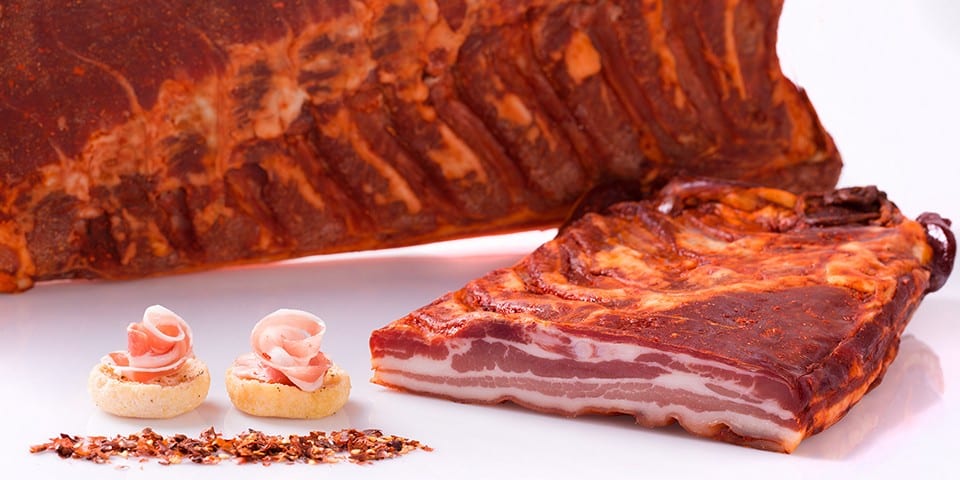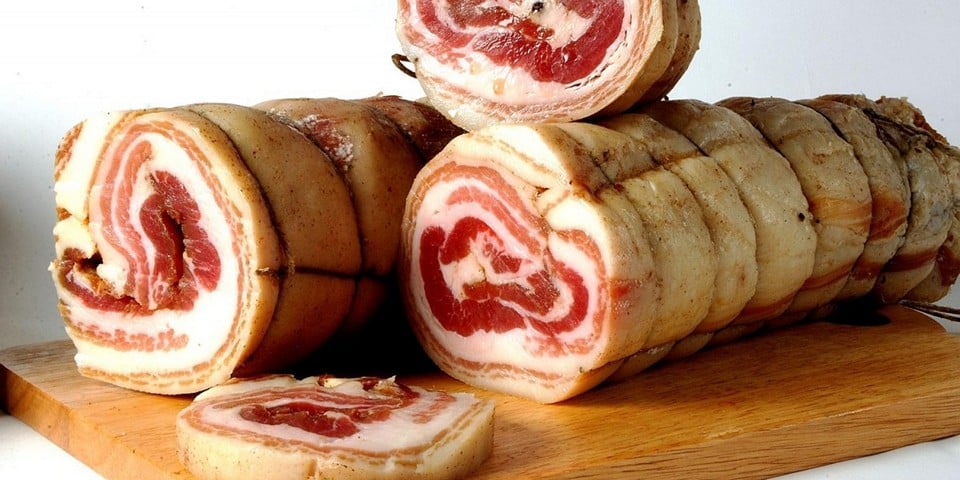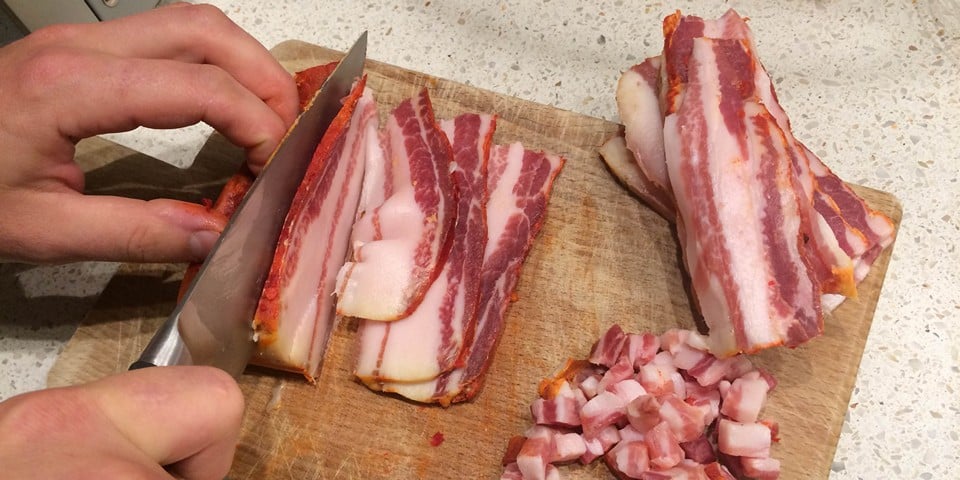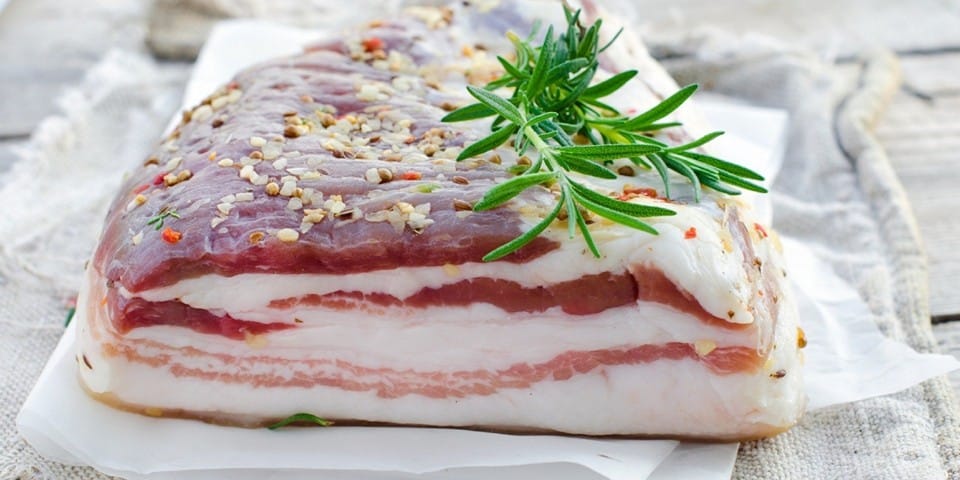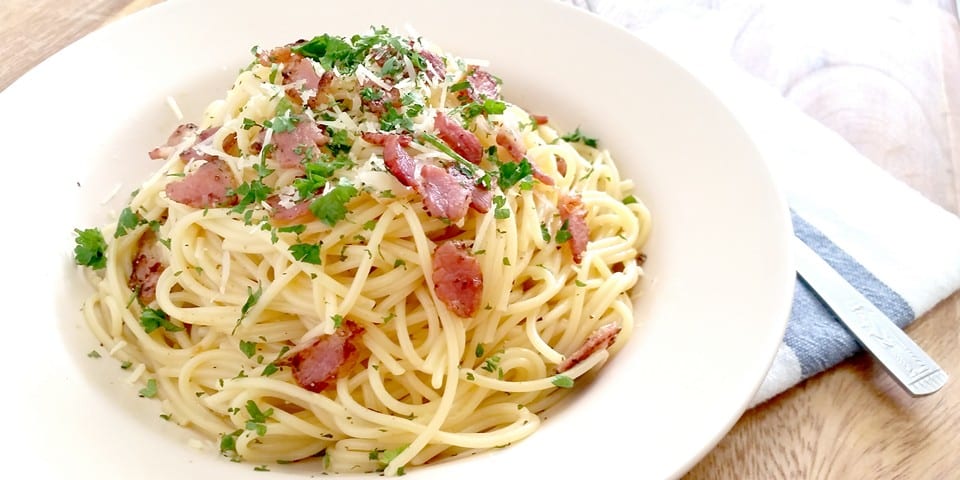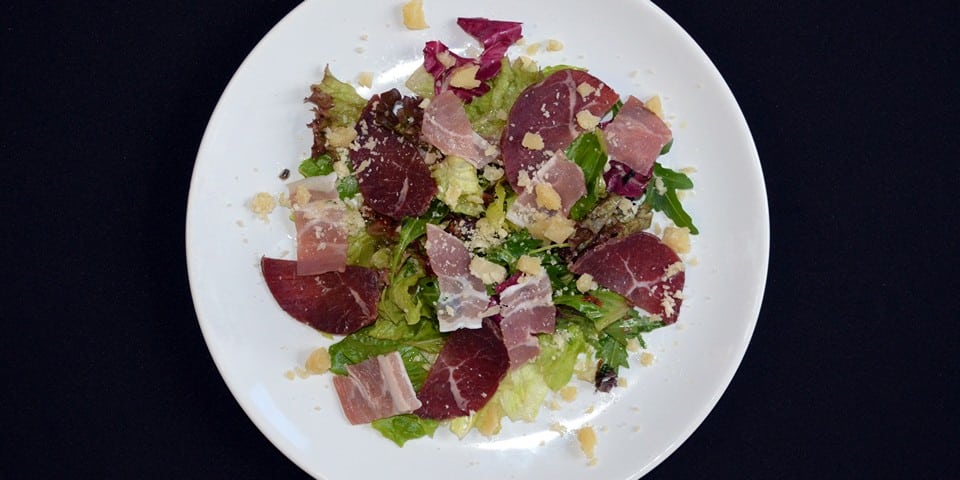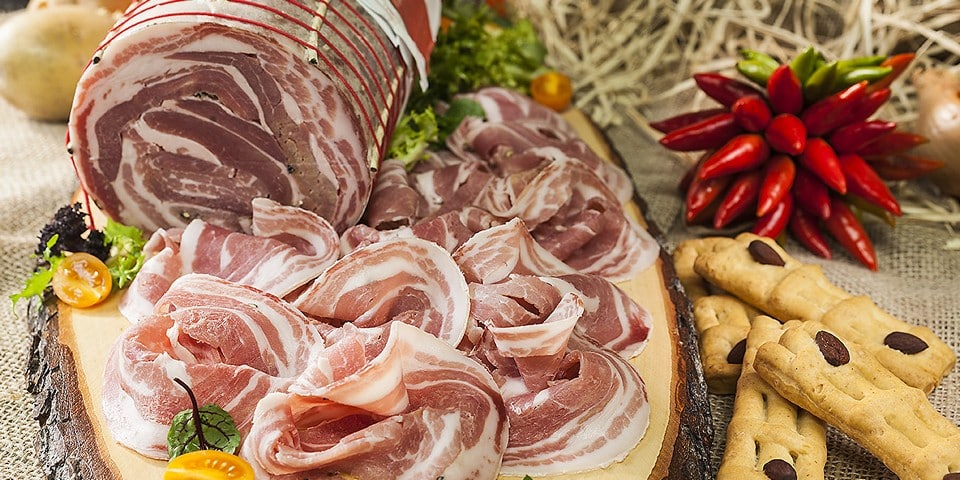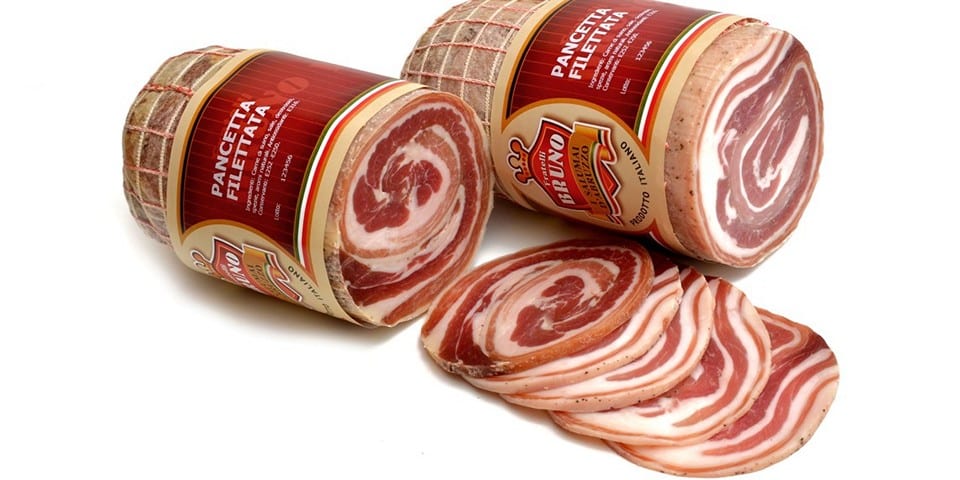Never before in human history has so much meat been consumed as it is now. The livestock population continues to grow each year. However, the quantity of consumed products is not the sole indicator of the standard of living. The quality of meat products is the primary goal of conscientious producers.
Italian Pancetta is a true example of a perfect product – it is the Italian version of bacon made from pork belly. There are different types of Pancetta, two of which are classified as DOP. But not all varieties of Pancetta closely resemble their American cousin in appearance. Let us now tell you what Pancetta is.
Page Contents
What You Need to Know about Italian Pancetta
What is Pancetta made from?
What does Pancetta taste like?
How long does Pancetta last in the fridge?
Is Pancetta healthy?
How to cook Pancetta?
Origin and Varieties
The preservation of meat products through salting and curing methods in Italy dates back to as early as 900 BC. Therefore, it is presumed that the first versions of Pancetta appeared during those years. Roman legionnaires had this dish in their ration every three days.
Like many other exquisite products, Pancetta remained the prerogative of the affluent classes for a long time. It was only with the advent of technological progress and the launch of mass production of meat products in the early 20th century that it became accessible to the majority of people.
In modern times, there are three varieties of Pancetta based on the preparation method:
- Pancetta Tesa – This product has a flat shape, similar to bacon.
In the initial stage, it is sprinkled with a mixture of salt and spices and left to rest in a cool place to allow the spices to evenly penetrate the meat, occasionally wiping it with white wine. Afterward, the product undergoes a drying process in special rooms for 3 to 5 days. The subsequent aging period lasts for at least 2 months. The sliced Pancetta exhibits a characteristic alternating pattern of bright red and white layers. - Pancetta Arrotolata – This meat product has a rolled shape.
It is wrapped in such a way that the spices and herbs are enclosed inside the product, often covered with natural casing. It is usually made from leaner cuts of meat, resulting in a sliced Pancetta with predominance of red meat layers. The salting process takes place in special tanks in a refrigerated environment and lasts for about a month. The duration of the subsequent aging stage depends on the diameter of the product and varies from 2 to 4 months. - Pancetta Coppata – This product is a combination of two types of cured meats: Pancetta and Coppa.
It involves wrapping the pork belly with lean meat from the pig’s neck. The distinctive feature of this variety of Pancetta is that the sliced product is almost entirely meat with thin strips of fat, which are minimal compared to other varieties.
There are variations of Pancetta that do not require extensive aging and are available fresh in the market:
- Affumicata – Pancetta with the skin, smoked in special ovens. It is closest to American bacon.
- Cubettata – Skinless Pancetta that undergoes salting and drying for 15 days. It is cut into small cubes, packaged, and sold.
Some varieties of Pancetta have received high recognition from the European Union and have been awarded the DOP (Protected Designation of Origin) status. In 1996, Pancetta from Piacenza (Pancetta Piacentina) was honored with this prestigious recognition, and in 1998, it was the Pancetta from Calabria (Pancetta di Calabria).
Pancetta di Calabria
Pancetta di Calabria is a product whose entire production cycle, starting from raising the pigs, takes place in the region of Calabria. The rectangular-shaped pork belly with skin, weighing 3-4 kg, is salted for 4-8 days. Then it is rinsed and soaked in wine vinegar. A small amount of chili pepper is sprinkled on the surface. It is then aged for at least 30 days in rooms with controlled temperature and humidity.
The final product has a thickness of 3-4 cm. The surface has a red color, and the sliced Pancetta is pink with alternating layers of white fat. It has a pleasant and intense flavor. The top part has a slight spiciness due to the use of chili pepper. It is sold both in bulk and pre-sliced in vacuum packaging.
Pancetta Piacentina
Pancetta Piacentina is a meat product produced in a rolled form, typical of the province of Piacenza in the Emilia-Romagna region. The weight of the pigs used for its production must be at least 160 kg. Salt, sugar, and spices such as black and white pepper and cloves are used for the salting process. The use of sodium nitrates and nitrites in minimal amounts (not exceeding 10 g per 100 kg of raw material) is allowed. The finished pork belly is scraped to remove any remaining spices, rolled into a roulade, and placed in a natural casing. The product is dried at a temperature of 15-25 degrees Celsius for about a week. The aging stage lasts for at least 4 months.
The shape of the finished Pancetta Piacentina is cylindrical, weighing from 4 to 8 kg. The sliced Pancetta has a bright red color with white fat marbling. It has a pleasant aroma with fruity notes and a sweet taste. It is sold either in bulk or pre-sliced in vacuum packaging.
Difference from Bacon
The terms “bacon” and “Pancetta” are often used interchangeably, but there are several significant differences:
- Pancetta is made exclusively from pork belly, while bacon is not limited to specific cuts. Bacon can come from various parts of the pig, including the belly, back, neck, and thighs.
- Bacon usually does not undergo an aging process. It is either smoked or baked in an oven and then sold. Pancetta, on the other hand, requires a stage of drying and aging. Smoked Italian Pancetta is a relatively rare occurrence, mostly found in the Trentino-Alto Adige region.
- Bacon often has a higher proportion of fatty layers compared to the leaner Pancetta.
Lastly, the difference in their respective regions of origin has a significant influence on the flavor profile of the products. While Pancetta is a truly Italian creation, bacon is characteristic of the Anglo-Saxon world as a whole.
Homemade Pancetta Recipe
Making Pancetta at home is relatively simple, although it’s worth noting that the end result is more like Italian-style bacon. To truly taste the flavors of Italy, one would need to enjoy it in the country itself.
- Pork belly – 1 kg
- Coarse salt (preferably sea salt) – 250 g
- Ground black pepper – 3 tsp
- Ground green pepper – 1 tsp
- Brown sugar – 1 tsp
- Garlic – 1 tsp
- Coriander seeds – 1 tsp
- Paprika – 1 tsp
- Rosemary – a pinch
- Thyme – a pinch
- Bay leaf – 1
First, prepare the spice blend. Mix all the spices together and grind them using a mortar and pestle. Place the pork belly on a cutting board and rub it thoroughly with the spice blend, ensuring that the entire surface, including the sides, is coated. Then, generously sprinkle the salt over the pork belly, forming a layer approximately 1 cm thick. This helps draw out excess moisture and initiates the preservation process.
Place the seasoned pork belly in the refrigerator, slightly tilted, with a container underneath to collect any drippings. Allow it to cure for a minimum of 5 days. During this time, the height of the pork belly should decrease by about one-third. Next, create a small hole and hang the pork belly in a cool, dark place (such as a cellar) for one week. To protect it from insects, you can cover it with a large cloth bag.
After a week, rinse the Pancetta under running water to remove any excess salt. You can use vinegar or wine instead of water for this step. Thoroughly dry the Pancetta and rub it with the same spice blend mixture. Hang it again in a cool place for another 2 weeks. At the end of this process, you will have a delicate Pancetta tesa that is fully ready to be enjoyed.
Recommendations
When trying out new recipes, homemakers often have various questions. Here are some tips:
- When choosing the pork belly, avoid selecting a piece that is too thick; otherwise, the curing process may not be thorough. Aim for a balanced ratio of meat and fat, around 50:50.
- It is preferable to use pork belly with the skin intact, as it helps maintain the shape of the final product.
- Feel free to customize the spice blend by adding your preferred spices. Some people complement the flavors with red pepper, while others add dill seeds. The quantity of spices can also be adjusted according to your taste.
- A second round of curing with spices is optional, but it adds depth to the Italian flavor of your Pancetta.
- The finished Pancetta can be stored for about 3 weeks. To extend its shelf life for several months, you can place it in the freezer.
How to Enjoy Pancetta and What to Pair It With
Pancetta, like many Italian products, is versatile in the kitchen. It can be enjoyed both in its raw form and used in various recipes. Pancetta Tesa is often diced, while Pancetta Arrotolata is sliced thinly. Smoked Pancetta is perfect for sandwiches.
Pancetta is commonly used to add flavor and moisture to dry ingredients during roasting or frying. It can be wrapped around meats, fish, and vegetables. Leaner varieties of Pancetta can serve as an alternative to beef or chicken. It adds a savory taste to main dishes, soups, and stews.
Pancetta di Calabria is an essential ingredient in Carbonara sauce. It pairs well with polenta and is delicious when combined with crusty bread and cheese. It is often served as an appetizer alongside Calabrian wines.
Pancetta Piacentina is frequently enjoyed in its raw form. It is accompanied by braised beans and cheese. It adds a unique flavor to vegetable pies and can be sprinkled over soups after being finely chopped and sautéed.
Of course, there are numerous salads featuring Pancetta. Here, we present a light yet satisfying recipe for your enjoyment.
Salad «Pancetta»
To prepare the Pancetta Salad, you will need:
- Pancetta: 450 g
- Mayonnaise: 180 ml
- Milk: 60 ml
- Dry minced garlic: 3 g
- Chinese lettuce: 1 head
- Large tomatoes: 2 pieces
- White bread croutons: 80 g
- Salt and black pepper to taste
Here’s how to make the salad:
- Start by thoroughly washing the lettuce and tomatoes, then chop them into medium-sized pieces.
- Cut the Pancetta into small cubes and sauté them until golden brown.
- In a blender, combine mayonnaise, milk, minced garlic, salt, and pepper. Blend until smooth and well combined.
- In a salad bowl, mix the vegetables with the Pancetta and dress them with the sauce.
- Serve the salad, garnished with white bread croutons.
Calorie Content and Benefits
It’s true that Pancetta is a relatively fatty and calorie-dense food. It is rich in cholesterol and sodium. In 100 g of Pancetta, there are approximately 458 kcal, composed of:
-
- Protein: 11.6 g
- Fat: 45.04 g
- Carbohydrates: 0.66 g
Around 33% of the fats in Pancetta are saturated. Additionally, 100 g of this delicacy contains about 68 mg of cholesterol. Therefore, the consumption of Pancetta is not recommended for individuals with obesity, high cholesterol levels, or hypertension.
Attempting to reduce the calorie content of Pancetta by grilling it may not be the best option. Removing some of the fat can lead to the formation of carcinogenic compounds called benzopyrenes, which are associated with cancer.
Pancetta is not particularly rich in vitamins and minerals, so its consumption is mostly for culinary enjoyment. It is advisable to consume Pancetta in moderate portions and not include it in the diet too frequently.
For a healthy middle-aged person, the calories derived from consuming 50 g of Pancetta can be burned by walking for an hour or swimming for approximately 20 minutes.
Price in Italy
The price of Pancetta in Italy varies depending on its variety, aging time, and producer. It ranges from 7.8 to 18.9 Euros per kilogram of the product.
Whether long or short, the story about this Italian delicacy has come to an end. Although the health benefits of Pancetta may not be significant, denying yourself the pleasure of trying this legendary product while traveling in Italy would be a huge mistake. Live right, laugh heartily, travel passionately, and remember: “Pancetta is best enjoyed in moderation!”
Interesting Facts
- Pancetta is a popular Italian cured meat made from pork belly. It is seasoned with a blend of salt, black pepper, and various herbs and spices, then cured for several weeks to develop its distinct flavor and texture.
- The origins of Pancetta can be traced back to ancient Rome, where it was prepared as a way to preserve and flavor pork. It has since become a staple in Italian cuisine and is enjoyed for its rich, savory taste.
- Italian Pancetta is known for its delicate balance of flavors. It has a slightly salty and tangy taste with hints of sweetness and a subtle herbal aroma. Its texture is smooth and fatty, which lends richness to cooked dishes.
- Pancetta is a versatile ingredient used in a variety of Italian dishes. It is commonly diced or sliced thinly and added to pasta sauces, soups, stews, and salads to enhance their flavor. It can also be enjoyed on its own as part of a charcuterie platter.
- The curing process of this meat involves rubbing the pork belly with a mixture of salt, spices, and herbs, then allowing it to air-dry for an extended period. This process preserves the meat and imparts complex flavors that develop over time.
- Pancetta is often used as a substitute for bacon in recipes, although it has a milder flavor and is not typically smoked. It offers a more nuanced and less overpowering taste, making it a versatile ingredient in both traditional and modern Italian cooking.
- The quality of Pancetta can vary depending on factors such as the breed of pig, the ingredients used in the curing process, and the length of time it is aged. Artisanal producers take great care in crafting high-quality Pancetta, resulting in exceptional flavor and texture.
 Italy for me From Italy with love
Italy for me From Italy with love



